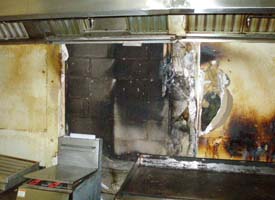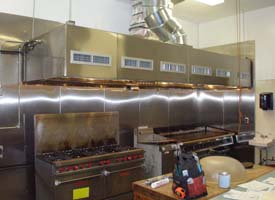Frequently Asked Questions
Fire Extinguisher Questions
WHO SHOULD SERVICE AND MAINTAIN OUR FIRE EXTINGUISHERS?
Maintenance and servicing of fire extinguishers should be performed by a licensed and insured fire extinguisher servicing company that has the proper tools, training, recharge materials, lubricants, manufacturer’s servicing instructions, and replacement parts.
Learn more about our Extinguisher Inspection process.
HOW OFTEN SHOULD MY FIRE EXTINGUISHERS BE CHECKED?
- Monthly – Quick check to ensure that the fire extinguisher is in the designated place with no obstruction to access or visibility, and that the pressure gauge indicator is in the operable range.
- Annually – A thorough examination of the basic elements of the fire extinguisher performed by a trained person who has undergone the necessary instructions and has the manufacturer’s service manual.
Learn more about our Extinguisher Inspection process.
WHAT IS THE ANNUAL MAINTENANCE PROCEDURE FOR A FIRE EXTINGUISHER?
- Locate the fire extinguisher: check for access to, visibility, and locator sign. The extinguisher shall not be obstructed. Examine the bracket stability, extinguisher height and that the proper unit is located for the hazard area.
- Remove the fire extinguisher from the bracket: check hydrostatic test date, six year maintenance date (dry chemical) and general condition of the cylinder and band. The operating instructions on the extinguisher name plate shall be legible and face outwards.
- Weigh the cylinder, check the gauge, remove the safety pin and tamper seal. Inspect handles for proper operation. Reinsert the safety pin with a new seal.
- Remove hose, horn or nozzle. Check for obstructions, wear and proper operation. Reassemble all equipment.
- A conductivity test shall be conducted on all carbon dioxide hose assemblies. Hose assemblies found to be nonconductive shall be replaced.
- Thoroughly clean all equipment, replace worn labels and attach new annual NFPA-10 inspection tag.
- Reinstall unit on bracket back to service.
- When an inspection reveals that tampering has occurred or the unit is due for extended maintenance, the unit must be taken out of service. A spare fire extinguisher suitable for the hazard being protected of equal or greater rating shall be left.
WHAT IS A HYDROSTATIC TEST?
Pressure testing of a fire extinguisher to verify its strength against unwanted rupture performed by a facility that is approved by the D.O.T. to requalify cylinders.
HOW OFTEN IS A HYDROSTATIC TEST REQUIRED?
- Dry Chemical 12 years
- Water, AFF, FFFP 5 years
- Halogenated Agent 12 years
- Carbon Dioxide 5 years
WHAT IS A SIX YEAR MAINTENANCE?
An internal examination of an emptied dry chemical fire extinguisher to check for corrosion and any interior problems. Extinguishers that pass the six year maintenance are then recharged, reassembled, and receive a six year service label and a verification of service collar.
WHAT ARE THE CLASSES OF FIRE?
- Class A Wood, Paper, Cloth, Rubber
- Class B Flammable Liquids
- Class C Electrical
- Class D Combustible Metals
- Class K Combustible Cooking Media
WHAT IS THE MAXIMUM TRAVEL DISTANCE FOR FIRE EXTINGUISHERS?
- Class A 75 Feet
- Class B 50 Feet
- Class D 75 Feet
- Class K 30 Feet
AT WHAT HEIGHT SHOULD FIRE EXTINGUISHERS BE INSTALLED?
- Fire extinguishers having a gross weight not exceeding 40 pounds shall be installed so that the top of the fire extinguisher is not more than 5 feet above the floor.
- Fire extinguishers having a gross weight exceeding 40 pounds shall be installed so that the top of the fire extinguisher is not more than 3 1/2 feet above the floor
- In no case shall the clearance between the bottom of the fire extinguishers and the floor be less than 4”.
I HAVE A FIRE EXTINGUISHER WITH A 4-A:60-B:C RATING, WHAT DOES THIS MEAN?
- It should extinguish approximately twice as much Class A fire as a 2-A rated fire extinguisher.
- It should extinguish approximately six times as much class B fire as a 10-B rated fire extinguisher.
- It is suitable for use on energized electrical equipment.
WHAT TYPE OF FIRE EXTINGUISHER SHOULD I GET FOR MY HOME?
The following are NFPA-10 minimum recommendations per floor:
- A single fire extinguisher rated 2-A:10-B:C or higher.
- One single fire extinguisher rated 2-A or higher, and a second fire extinguisher rated 10-B:C or higher.
WHAT FIRE EXTINGUISHERS ARE CONSIDERED OBSOLETE BY NFPA-10 2007?
- The following types of fire extinguishers are considered obsolete and shall be removed from service:
- Soda acid
- Chemical foam (excluding film-forming agents)
- Vaporizing liquid (e.g., carbon tetrachloride)
- Cartridge-operated water
- Cartridge-operated loaded stream
- Copper or brass shell (excluding pump tanks) joined by soft solder or rivets
- Carbon dioxide extinguishers with metal horns
- Solid charge type AFFF extinguishers (paper cartridge)
- Pressurized water extinguishers manufactured prior to 1971
- Any extinguisher that needs to be inverted to operate
- Any stored pressure extinguisher manufactured prior to 1955
- Any extinguisher with 4B, 6B, 8B, 12B, and 16B fire ratings
- Stored pressure water extinguishers with fiberglass shells (pre-1976)
- Dry chemical stored pressure extinguishers manufactured prior to October 1984 shall be removed from service at the next 6-year maintenance interval or the next hydrostatic test interval, whichever comes first.
- Any fire extinguisher that can no longer be serviced in accordance with the manufacturer’s maintenance manual is considered obsolete and shall be removed from service.
Fire Suppression System Questions
WHY ARE FIRE PANELS REQUIRED?
WHO SHOULD SERVICE AND MAINTAIN SPECIAL HAZARD FIRE SUPPRESSION SYSTEMS?
Maintenance and servicing of special hazard fire suppression systems should be performed by a licensed and insured special hazard fire suppression servicing company with Factory trained and Certified Service Technicians.
Browse our Fire Suppression Systems.
HOW OFTEN SHOULD MY SYSTEMS BE INSPECTED?
Semi-Annually
WHAT IS A FUSIBLE LINK?
Fusible links are temperature sensitive fire protection devices designed to be part of a fire protection system. The Fire Suppression System is activated when the ambient temperature increases to the point that causes the fusible link to break apart.
HOW OFTEN DO FUSIBLE LINKS NEED TO BE REPLACED?
Semi-Annually
WHAT IS UL-300?
UL-300 is the Standard for the Testing of Fire Extinguishing Systems for Protection of Restaurant Cooking Areas, effective since November 21, 1994. All new restaurant cooking area fire protection systems manufactured after the effective date must comply with UL-300 for a UL listing.
HOW DO I KNOW IF MY KITCHEN EXHAUST HOOD SYSTEM MEETS UL-300 STANDARDS?
Obvious Indicators that your kitchen exhaust hood system does not meet UL-300
would include:
- No UL-300 label on the system’s cylinder(s)
- Installed prior to 11/21/1994
- Dry chemical extinguishing media
- Dry chemical discharge nozzles – large size- 2” diameter heads
- System uses water spray or CO2 to protect appliances
- System uses a single nozzle to protect multiple appliances or multiple cooking surfaces
WHAT IS UL?
Underwriters Laboratories Inc. (UL) is an independent, not for profit product safety testing and certification organization. UL has tested products for public safety since its founding in 1894.
WHAT ARE THE CLEARANCES REQUIRED BY CODE FROM MY KITCHEN EXHAUST HOOD AND DUCTWORK TO COMBUSTIBLE, LIMITED COMBUSTIBLE, AND NONCOMBUSTIBLE MATERIALS?
NFPA-96 Section 4.2.1 requires a clearance of 18” to combustible material, 3” to limited-combustible material, and 0” to noncombustible material.
WHY DOES MY KITCHEN EXHAUST HOOD NEED TO BE WELDED?
NFPA-96 Section 5.1.2 requires that all seams, joints and penetrations of the hood enclosure that direct and capture grease-laden vapors and exhaust gases shall have a liquidtight continuous external weld to the hood’s lower outermost perimeter. This helps to contain a fire within the hood where it can be extinguished by the exhaust hood’s fire suppression system.
Browse our Kitchen Hoods.


